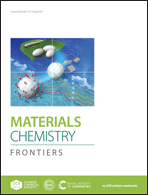Formation of a lead chalcogenide quantum dot-based supramolecular polymer network via pillar[5]arene-based host–guest complexation†
Abstract
Due to their technological and scientific significance, materials which possess photoluminescence properties are widely applied in numerous fields. Despite recent advances in quantum dot (QD)-based self-assembled materials, QD-based fluorescent supramolecular polymers are still rare due to the fact that the current QD-based self-assembly methods cannot be used for the construction of large assemblies or in three-dimensional accessible formats. Here, we achieve a lead chalcogenide (PbS) QD-based supramolecular polymer network via host–guest complexation of pillar[5]arene. A cross-linked supramolecular polymer network spontaneously formed by host–guest complexation between pillar[5]arene cavities and pyridinium groups. Then, a PbS QD-based fluorescent supramolecular polymer network is obtained by adding Pb2+ and S2− to a solution of the supramolecular polymer. The PbS QD-based fluorescent supramolecular polymer network can be used for living cell imaging. The realization of this QD-based supramolecular polymer network is expected to provide new opportunities for fabricating QD-based functional materials.
![Graphical abstract: Formation of a lead chalcogenide quantum dot-based supramolecular polymer network via pillar[5]arene-based host–guest complexation](/en/Image/Get?imageInfo.ImageType=GA&imageInfo.ImageIdentifier.ManuscriptID=D1QM00699A&imageInfo.ImageIdentifier.Year=2021)
- This article is part of the themed collection: 2021 Materials Chemistry Frontiers HOT articles


 Please wait while we load your content...
Please wait while we load your content...